
The ceremony to award the 2025 Lumen Prize for art and technology was held in Kunstsilo museum, Kristiansand, south Norway, on November 8. Honoring the shortlisted artists and winners of nine subject categories and four special awards, the prize’s CEO, Gillian Leitten, said that Lumen is looking for new partners for a prize that, since its foundation in 2012, has honored early-career artists who have gone on to earn global reputations, including Refik Anadol, Mario Klingemann, Operator and Casey Reas. “We want to work with more institutions, individuals, communities, collectors,” Leitten said.
“Anybody who wants to take part in this journey and this mission. We welcome you, let's talk, and let's make it possible for Lumen to be around forever.” (Gillian Leiten, CEO, The Lumen Prize)
The Lumen awards took place two days after the art fair giant Art Basel declared that digital art “is no longer at the margins” as it announced Zero 10, a new section dedicated to “art of the digital era”. Its curator, Eli Scheinman, said that the initiative would be launched at Art Basel Miami Beach (December 3 to 7) and that it would be “not upstairs, not offsite” but covering 10,000 sq ft of floor space and central to the fair experience in the Miami convention center. For Noah Horowitz, CEO of Art Basel, “Zero 10 reflects a strategic conviction: digital art is no longer at the margins—it is integral to how art and the market are evolving in real time.”
The fair promises, he said in a launch statement, to bridge “creative experimentation with sustained market development”. Zero 10 will feature the work of Lumen artists including, Reas, Klingemann and Maya Man.

The Lumen themes: borders, connection and critical optimism
In a year when borders, belonging, and the threat of deportation formed one of the main themes across the Lumen finalists, Rachel Falconer, Head of Creative Technology, Goldsmiths University, London, and author of The Liminal Review, an analysis of the 2025 prize entrants, presented the Gold Award for the prize entry receiving the highest jury score to the US-based collective MORAKANA (Tiri Kananuruk & Sebastián Morales Prado) for Cumulus. The work uses data from the National Oceanic and Atmospheric Administration (NOAA) weather satellites to contrast shifting skies over the Mexico-US border with the rigid nature of global politics.
The founder of the Lumen Prize, Carla Rapoport, presenting the award in her name to celebrate digital art that “amplifies underrepresented voices, ideas, and communities”, said that the 2025 winner of the Carla Rapoport Award, Andrey Chugunov, “could not be with us for a very resonant reason. He's a Russian national and could not get a visa to visit Norway. He's applying for citizenship in the UK. He lives in Scotland. We're really sorry he couldn't be with us.”
Another quality identified by the prize’s organisers in the 2025 entries was “critical optimism” — moving, Leitten writes in The Liminal Review, “beyond dystopian technological narratives toward practices grounded in care, empathy, and transformation”. Chugunov, in a statement read out at the awards ceremony by Rapoport in his absence said “Technology can become a form of care — a way of witnessing what is unstable and vanishing, holding it with attention rather than control, with resistance and acceptance intertwined.”

Sasha Stiles, winner of the Literature & Poetry Award for her AI-infused infinite poem WORDS BEYOND WORDS, said that being honored in this way was a reminder that “the reason that I work with technology, the reason I do what I do is because technology is about connection and inspiration and community and collaboration.
"It's not about pulling off magic tricks with fancy tools. It's really about finding new ways to connect with each other, finding new ways to create relationships”. (Sasha Stiles)
Navid Navab, winner of the Identity & Culture Award, told the audience of artists working with art and technology that he hoped “we can continue to collectively find ways of celebrating the preservation of lightness in our world and saying no to the military-cybernetic complex and to forms of violence at all possible scales. And instead joyfully stay with the eternal trouble of engaging in perpetual attunement, dialogue and generative forms of coming together.”
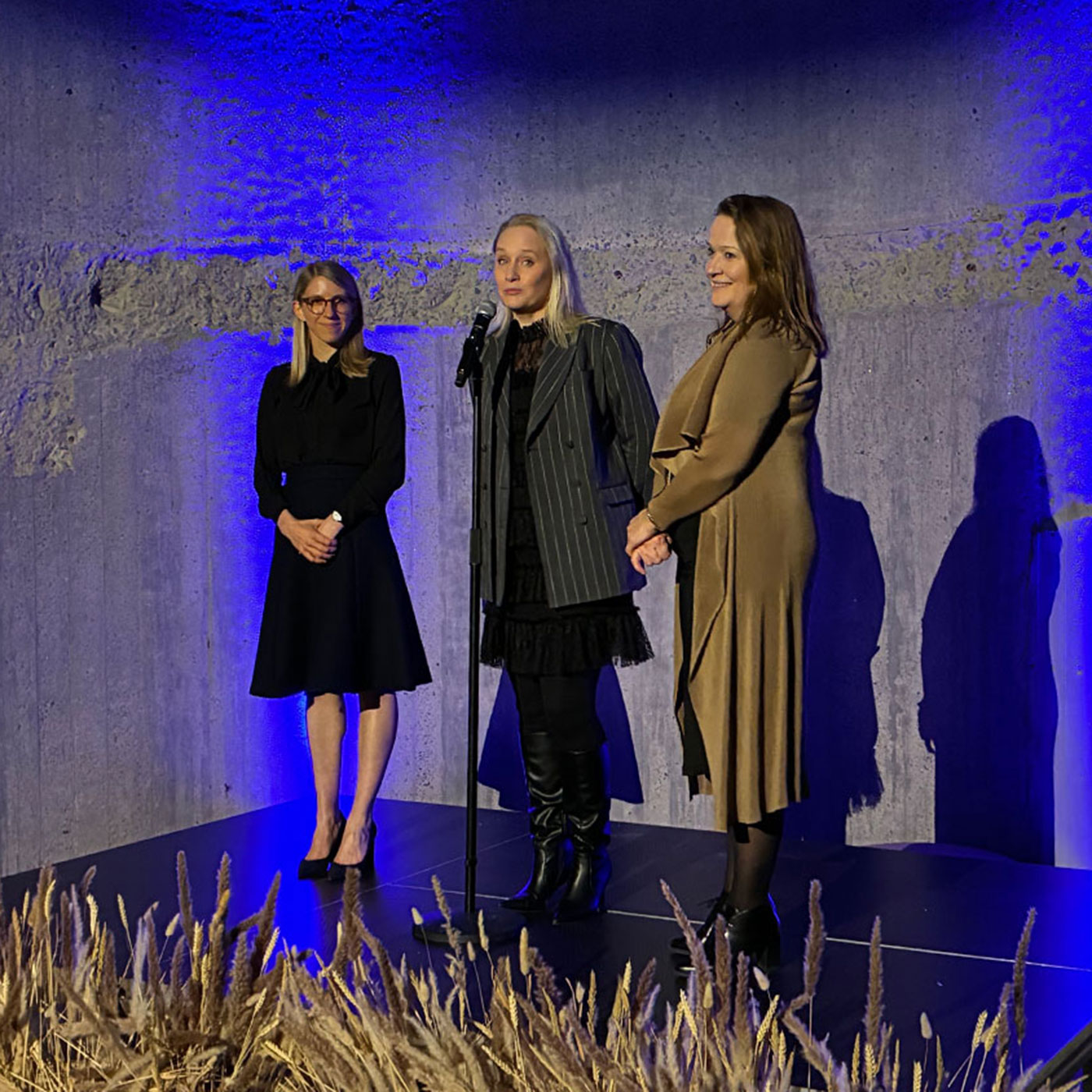
The Lumen Prize awards in 2025, Leitten said, were funded by the proceeds of a Sotheby’s online auction, held in October 2024, curated by Auronda Scalera and Alfredo Cramerotti, which offered lots donated by previous winners of Lumen Prize awards, including Stiles, Man, Sougwen Chung, Botto, 0xhaiku, and Fahad Karim. The awards included, for the first time, categories for Fashion & Design, Literature & Poetry, Performance & Music, and Hybrid (Digital / Physical). In 2025 the Lumen Prize received entries submitted by 2,243 artists from 71 countries; a 31.5% increase on the number of applicants for the 2024 iteration of the prize. Entrants were reduced by a committee of international selectors to a shortlist of finalists whose work was later reviewed by a separate jury panel.
“As [the Lumen team] enter an exciting new chapter on their journey they are looking for active partners and sponsors to create a more sustainable future for the prize as it evolves,” Falconer said at the awards ceremony.
“They need partners to enable Lumen to continue to innovate and celebrate across the arts and technology sector and sustain the incredible community of artists and practitioners that they have helped shine a light on, [signalling] seismic shifts across our industry.” (Rachel Falconer)
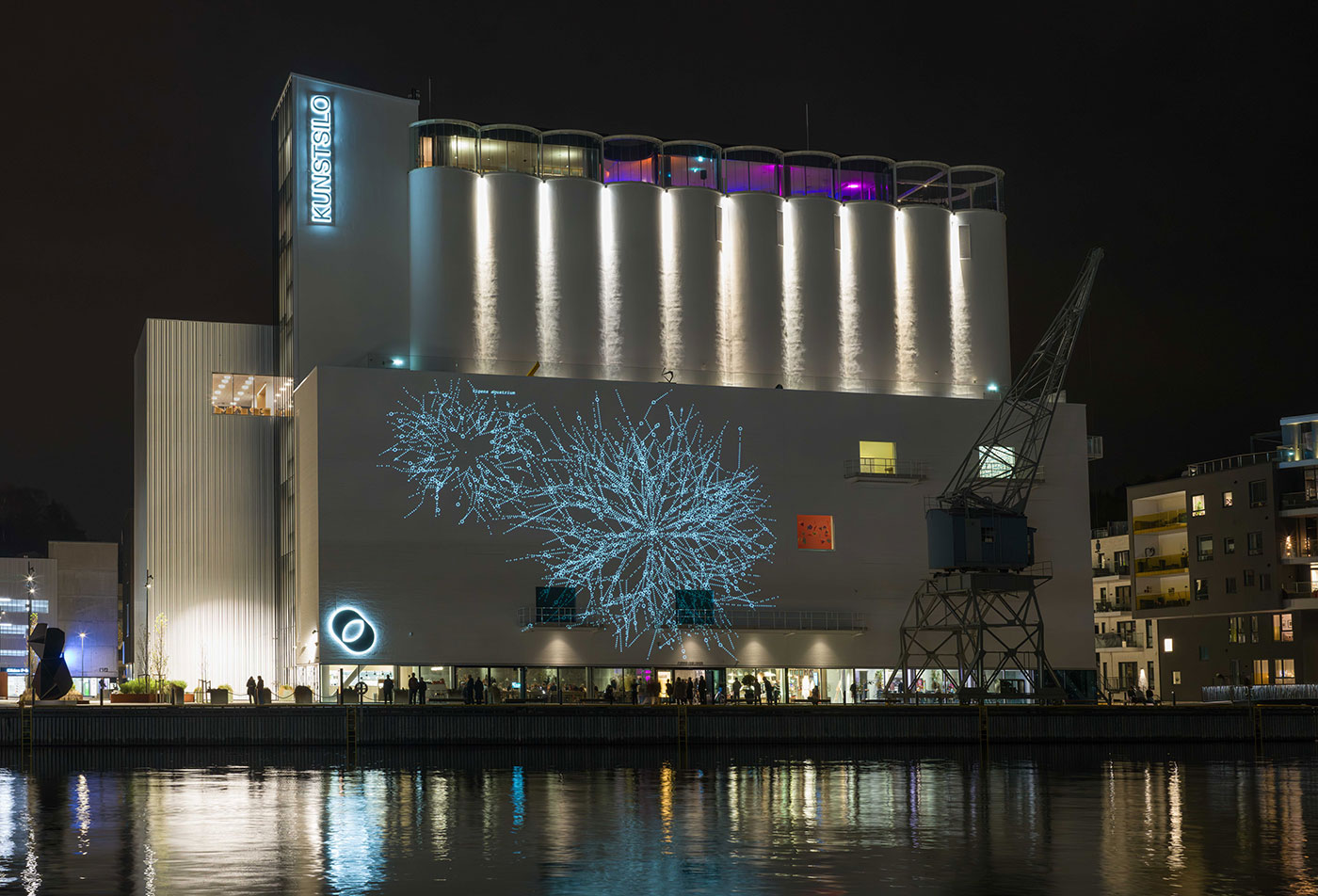
Kunstsilo: a functionalist landmark
The awards ceremony formed the third element of two days of events held at Kunstsilo, which has acted as sponsor to the Nordic Award category of The Lumen Prize since 2020, and is home to a remarkable collection of Nordic modern and contemporary art. The museum’s striking architecture, situated overlooking the harbour at Kristiansand, opened in 2024 following the remodeling, restoration, and enlargement of a 90-year-old grain silo which was one of the first functionalist buildings of the International school in Norway when it was erected in 1935. Its original design, by the Oslo firm of Korsmo & Aasland, drew on the fascination of two architects, Walter Gropius and Le Corbusier, with 1920s photographs of the towering reinforced-concrete grain elevators of the US Midwest.
The rebuilding project — won in an international competition by three Barcelona-based practices, Mestres Wåge Arquitectes, Mendoza Partida and BAX studio, and carried out in 2019-24 — carved a 21-metre tall atrium out of the heart of 30 existing concrete tubes, and placed new banks of gallery spaces on either side of the original structure.

At the Lumen award ceremony, held in the museum’s rooftop bar, looking west and east over the city’s harbour and the North Sea, the Norwegian artist Feileacan Kirkbride McCormick, co-founder, with Sofia Crespo, of Entangled Others Studio, winners of the Nature & Climate Award, told the audience that he had been born and raised near Kristiansand. He is also a former architect, he said, whose “former bosses” had worked on the recent remodelling of Kunstsilo: “It’s full circle,” McCormick said.
At dusk on November 7, the evening before the awards ceremony, a new commission, Growing, by the Lumen Prize-winning French collective Lab212, was projection-mapped onto Kunstsilo’s expansive west façade.
Created by Nicolas Guichard and Béatrice Lartigue of Lab212, the work makes use of real-time environmental data to present a generative meditation on ecological fragility, examining the role of invasive species as metaphors for expansion, imbalance, and adaptation.

From the Anthropocene to IP: the Lumen discussion panels
On the afternoon before the awards ceremony, Guichard and Lartigue were among the speakers when Lumen and Kunstsilo presented three panel discussions at the museum. They discussed Living Facades: Eco-Data, Growth & the Anthropocene with John Kenneth Paranada, Curator of Art and Climate Change at the Sainsbury Centre, University of East Anglia, in a discussion moderated by Leitten and Torill Haugen, Head of Innovation and Digital Development at Kunstsilo.
Guichard outlined the metaphors examined in the plant structure of Growing, which modifies its shape, responsively and gradually, each time a passer-by approaches a screen and camera (whose contents are not recorded) next to the museum entrance. The work addresses economic as much as organic growth, with an awareness of the danger of invasive plant species to Norway’s biodiversity as well as the cultural legacy of the imported grain that for decades filled the reinforced concrete storage tubes that were transformed into what is now Kunstsilo.
The plants depicted in Growing have “fantasized” names in Latin, Guichard said, designed to connect the economic and organic concepts behind the artwork.
The first part of each name comes from a term in economics, such as the Latin for “labor” or “profit”. “And then the name afterward is a real organic adjective, ‘montana’ or ‘maxima’,” with those adjectival terms represented in the plants’ appearance.
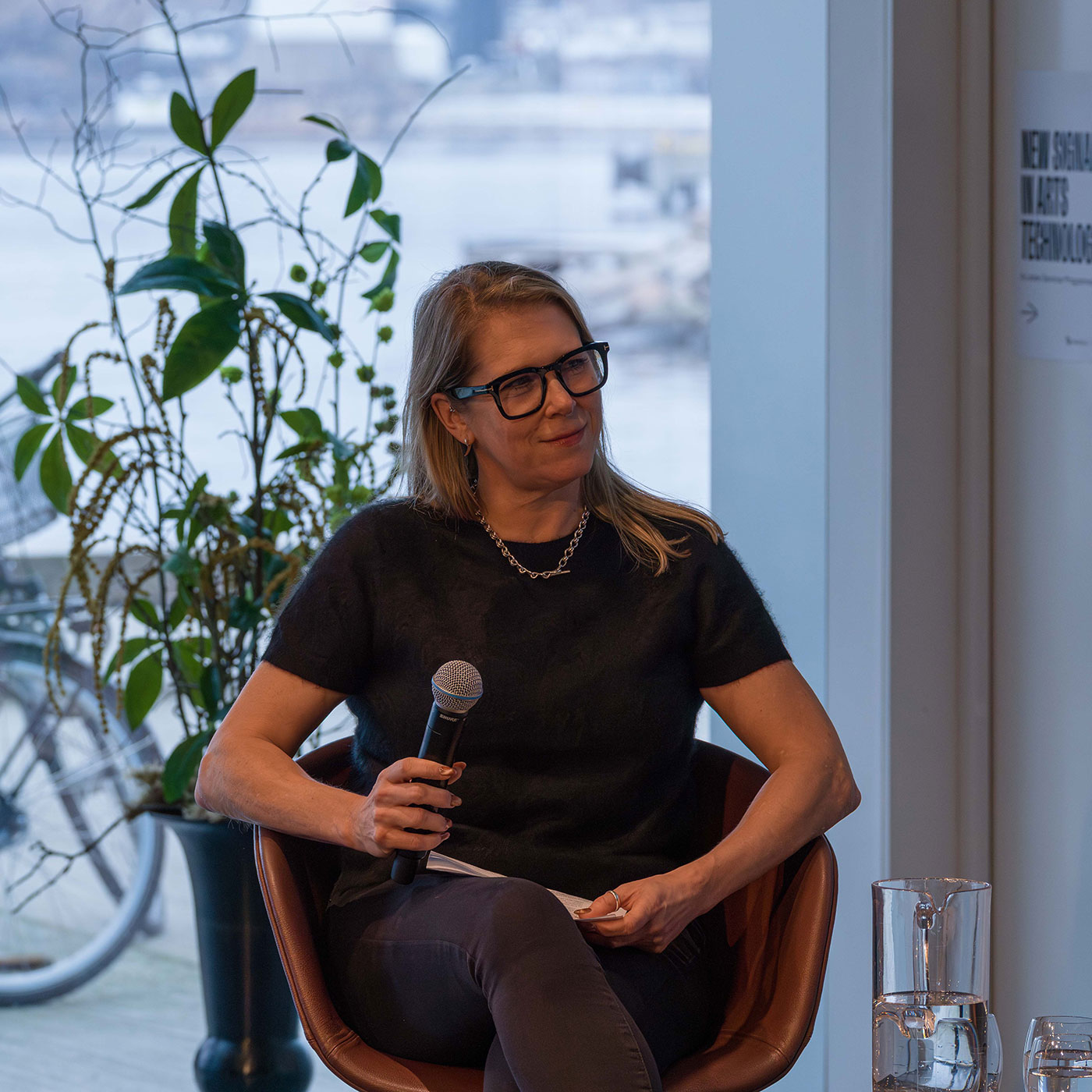
Falconer was the moderator on a second panel, Signals from the Future: Launching The Liminal Review, with three contributors to the review: Andrea Faroppa head of the Barcelona-based Sónar+D innovation strand of the Sónar festival; Annie Bicknell, Curator of Public Programming at Tate, London, and Myriam Achard, Chief, New Media Partnerships and Public Relations, at Centre PHI in Montreal. Faroppa and Bicknell were both members of the prize’s international selectors’ committee, and Achard a member of the jury panel.
Falconer summarised the themes of The Liminal Review as being “how artists metabolize experiences of rupture and loss through algorithmic and machinic systems; how we enchant the digital through ritual and spirituality; and reclaim erased histories through living or speculative archives.” Faroppa identified 2025 as a moment when the “hyper-techno-geek” need to innovate constantly is giving way to human creativity as “an art of resistance”, where technology is used to show what “makes us human; to connect us”. For Faroppa, digital culture, in the 2010s, was about optimization, but now it is “about reparation”.
In turn, Achard noticed a trend in the competition entries for “slowing down the tempo of digital experiences” with “longer immersive encounters, participatory rituals, [and] works that require shared attention or presence” — elements that “suggest a desire to re-humanize digital space and to move from content consumption to relational experience”. Bicknell referred to a project earlier in 2025 when she, Falconer and students from Goldsmiths and the University of the Arts London (UAL) had worked with the AI giant Anthropic in the galleries at Tate on the use of generative AI.
“Where we can bring big tech companies together with artists and creators, there can be some level of influence on the ethics and responsibility that are required in the designing of these systems.” (Annie Bicknell, Curator of Public Programming, Tate)

A third panel, Owning the Machine: IP & Authorship in the Age of AI, was moderated by Melanie Lenz, Digital Curator at the V&A, London. She was in discussion with Kayvan Ghaffari, a copyright lawyer at the New York-headquartered international law firm Pillsbury Winthrop Shaw Pitman; the Portuguese artist Tupac Martir, of Sartore Studio; and Daniel Nordgård of the University of Agder, Kristiansand, and Norway’s MishMash Centre for AI and Creativity.
All three panellists brought concrete examples to the discussion of both intellectual property (IP) and authorship. Nordgård drew parallels for the art world from his experience in working with copyright as it relates to music streaming platforms. He also recommended Professor Edward Lee of Santa Clara Law’s free Substack site Chat GPT Is Eating the World as a valuable resource on legal news in the field. Martir drew on the example of Leonardo da Vinci, who he views as running the first studio, where he worked with likeminded people and became “the face of everything that got made underneath it”. Martir understands LLMs (large language models), as well as the training data used in them, as “parts of the studio that are initiated by a human and then finished by a human.” Ghaffari reminded the audience that taking data from the internet to train LLMs is allowed in certain jurisdictions, including China, Japan, and the UK. However, the question is still being litigated in the US courts.
Ghaffari pointed out how some large AI companies now trumpet the option of allowing copyright-owners to “opt out” of their models, when the artists Mat Dryhurst and Holly Herndon had long since offered artists the tools to do so.
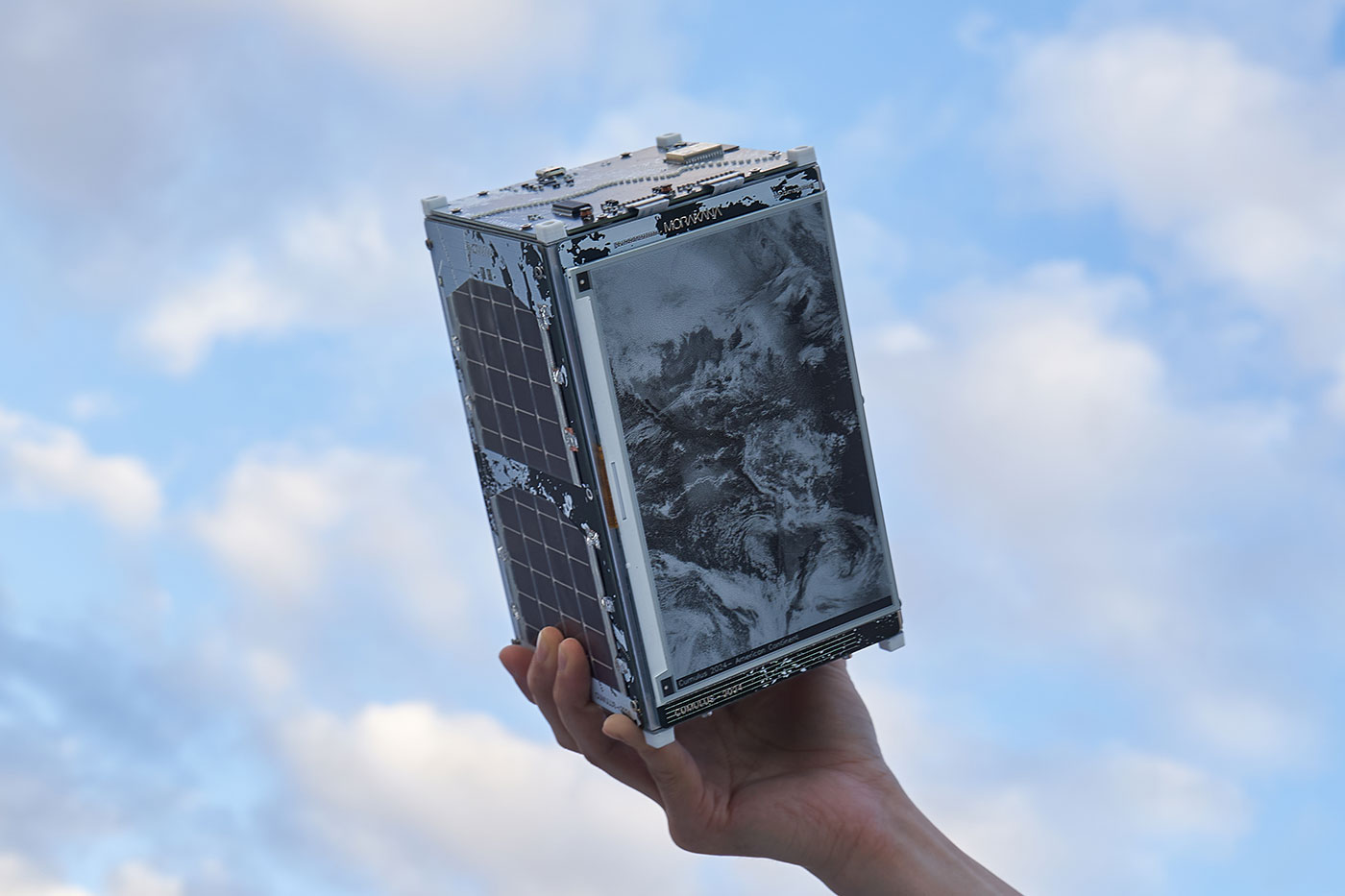
Gold Award
MORAKANA (Tiri Kananuruk & Sebastián Morales Prado), US, Cumulus
The New York-based studio MORAKANA describes Cumulus as a “networked device monitoring the Mexican-US border searching for clouds crossing the geopolitical division”, one that offers “a global perspective free of political demarcations, embodying the Overview Effect, a cognitive shift in awareness experienced by astronauts viewing the earth from outer space”.
Accepting the Gold Award with Tiri Kananuruk, Sebastián Morales Prado of MORAKANA said the studio had taken cloud patterns, from the US’s National Oceanic and Atmospheric Administration (NOAA) weather satellites over the US-Mexico border for Cumulus because these are such “hopeful” objects. “We’re trying to imagine new relationships with borders,” he said. “We all have relationships with borders, sometimes they’re more present. Right now, they’re very present for many of us. This work doesn’t offer a solution because it’s a complex problem, but it invites us to think about problems from a perspective from outside the world where you see the planet as a single object, as a unified floating fragile sphere in […] absolutely vast black space.”

Moving Image Award
Carlos Velandia and Angélica Restrepo, Colombia, This is not your Garden
In This is not your Garden, the Colombian film-makers Carlos Velandia and Angélica Restrepo examine memories and speculative futures, based on 500 years of colonial exploitation in Latin American, through the prism of the wetlands, alpine tundra ecosystems (or páramos) and ancient forests around the Colombian capital of Bogotà.
“This is a film about my hometown,” Velandia said at the awards ceremony, “or the landscapes that surround my hometown […] Here we made 3D scans of plants that are right now endangered and that live in fragile ecosystems that are disappearing.” He and Restrepo would like to dedicate this award, he said, “to this life that is ‘immaterialized’ in [the] film. I don't know if it will live for many decades in the future.”

Literature & Poetry Award
Sasha Stiles, US, WORDS BEYOND WORDS
The New York-based first-generation Kalmyk-American artist Sasha Stiles has worked for eight years with her alter ego, Technelegy, an AI system trained to emulate and augment her writing and voice, and has Living Poem on show in the Agnes Gund Garden Lobby at MoMA, New York, until spring 2026. WORDS BEYOND WORDS uses a custom generative language system to produce an infinite number of outcomes inspired by, but also departing from, poetic traditions.
Stiles said at the awards ceremony that it was enormously exciting to her that Lumen has created a poetry and literature category. “I think this is really meaningful,” Stiles said, “because we live in a time when everything we think we know about language is changing. And so I want to thank Lumen for recognizing that poetry is both a powerful, heroic, force and medium in the world of contemporary art, and that it’s also a technology, an ancient and enduring technology that really has so much to say to us about what it means to be human today in a world that’s increasingly post-human
"[Poetry] has so much to teach us about the relationship between emotion and logic, between intuition and algorithm, and between human and machine.” (Sasha Stiles)

Experiential Award
mots (Daniela Nedovescu and Octavian Mot), Germany, Deutsch / Nicht Deutsch
Deutsch / Nicht Deutsch was inspired by the process that Daniela Nedovescu and Octavian Mot went through to acquire German citizenship after moving from Romania to Germany 11 years ago. Speaking after receiving the award, Octavian Mot said that he and Nedovescu finally became German citizens “despite this silly piece of work”, one that playfully questions the boundaries around identity and handing over decisions to artificial intelligence (AI).
“So it’s supposed to be silly and fun but it’s actually more about belonging,” Mot said of the work. “And I noticed that a lot of the people in this room are either moving from their home countries for [one] reason or another or they’re trying to belong in a different society or a different group […] And I just want to say that to those of you that are still struggling to find where you belong, you just have to build it on your own. Whatever you move, whatever you try to be part of, you have to really work for that thing to happen.”
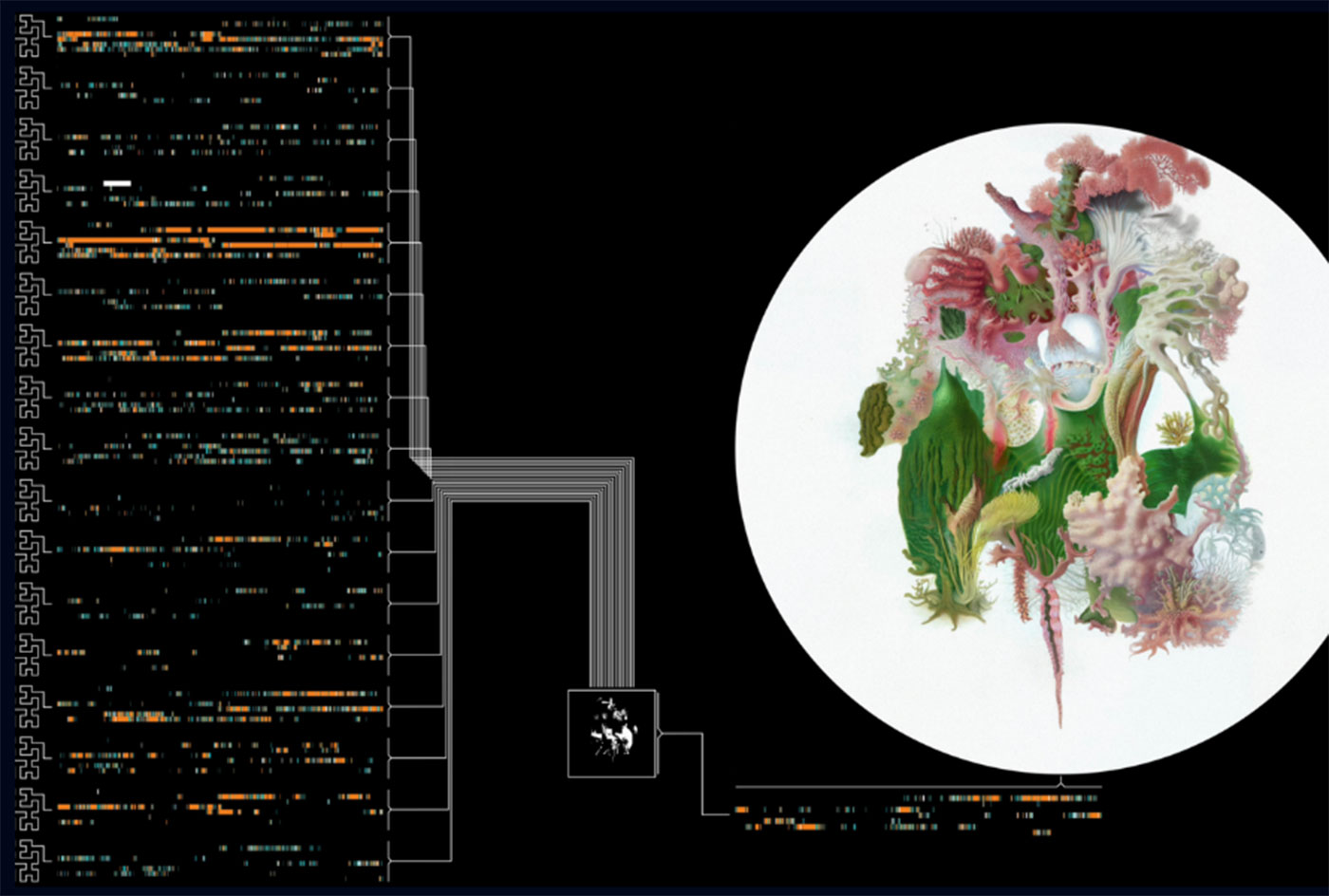
Nature & Climate Award
Entangled Others, Portugal, self-contained
Entangled Others has been working on the self-contained project, examining how information is encoded and decoded in both organic and digital systems, since 2023. They use image datasets to run a generative process in which a target image is iteratively “crossbred” with compressed fragments from other images; “randomly spliced”, as they write on their website, into the image “genome”. (The self-contained project is featured in the group exhibition “Subject to Change” at Gazelli Art House, London, until December 19.)
McCormick, speaking for the duo at the awards ceremony, in Crespo’s absence, said: “a lot of our work is about trying to unveil or somehow make tangible how entangled we are with the modern human realm around us. And so of course, this work is not just about exploring, encoding, and decoding information, but [also about] how to try and make tangible these processes that have led to everything around us”.

Performance & Music Award
Laura Mannelli and Sonia Killmann, France, Umweltraum((a))
Umweltraum((a)) is an immersive sound installation with live performance made as a collaboration between the Scotland-based Belgian artist and musician Sonia Killmann and Laura Mannelli, an architect-artist and immersive director from Luxembourg. The work’s title derives from the work of the German biologist Jakob von Uexküll (1864-1944) and his concepts of Umwelt and Umweltraum (literally translated as “environment” and "environmental space”). Uexküll argued that all living creatures inhabit a world, or environment, of their own; one that is determined by species but only revealed as part of an individual subjective experience.
This international project was commissioned by Cryptic Glasgow, the Scottish city’s centre for experimental music and audiovisual art, developed at Cove Park residency in western Scotland, supported by Kultur | lx (the Arts Council Luxembourg), and presented at Glasgow’s Centre for Contemporary Art as part of the 2024 Sonica Glasgow biennial of audiovisual art.

Still Image Award
Ana María Caballero, US, The Sylphs
The first-generation Colombian-American transdisciplinary artist Ana María Caballero created The Sylphs as part of her work Being Borges, a poetic and (post) photographic recasting, through AI visual prompting, of Jorge Luis Borges and Margarita Guerrero's Book of Imaginary Beings (1957).
The Book of Imaginary Beings, Caballero said at the awards ceremony, is “a compendium of humanity’s imagined creatures. It’s written in encyclopedic form because a lot of Borges’s works are about that thin line between fact and fiction. So it could be an encyclopedia of real creatures, but it’s not”. She wanted to visualize, she said, these sylphs, spirits of the air, through AI, “but I didn’t want to create a collection of monsters. I thought there were enough of those already, with or without AI”.
Caballero described her method: “I first take the original Spanish text and create a suite of images. Then I do the same with [an English] translation that Borges supervised. Finally, I write my own poem — not a translation but a reinterpretation that speaks to my own story.” She described the different prompted responses to these three variants. “In a very general sense, across the outputs, the Spanish generates more pastoral images, more landscapes, a more removed lens, while English usually summons images of people. And with my poems, I often obtain abstract results, which is fascinating as lyric writing tends to be compressed and symbolic.
“I’m fascinated by the literary implications of AI visual prompting, because I believe it represents a linguistic evolution, one we’ve yet to fully acknowledge.” (Ana María Caballero)
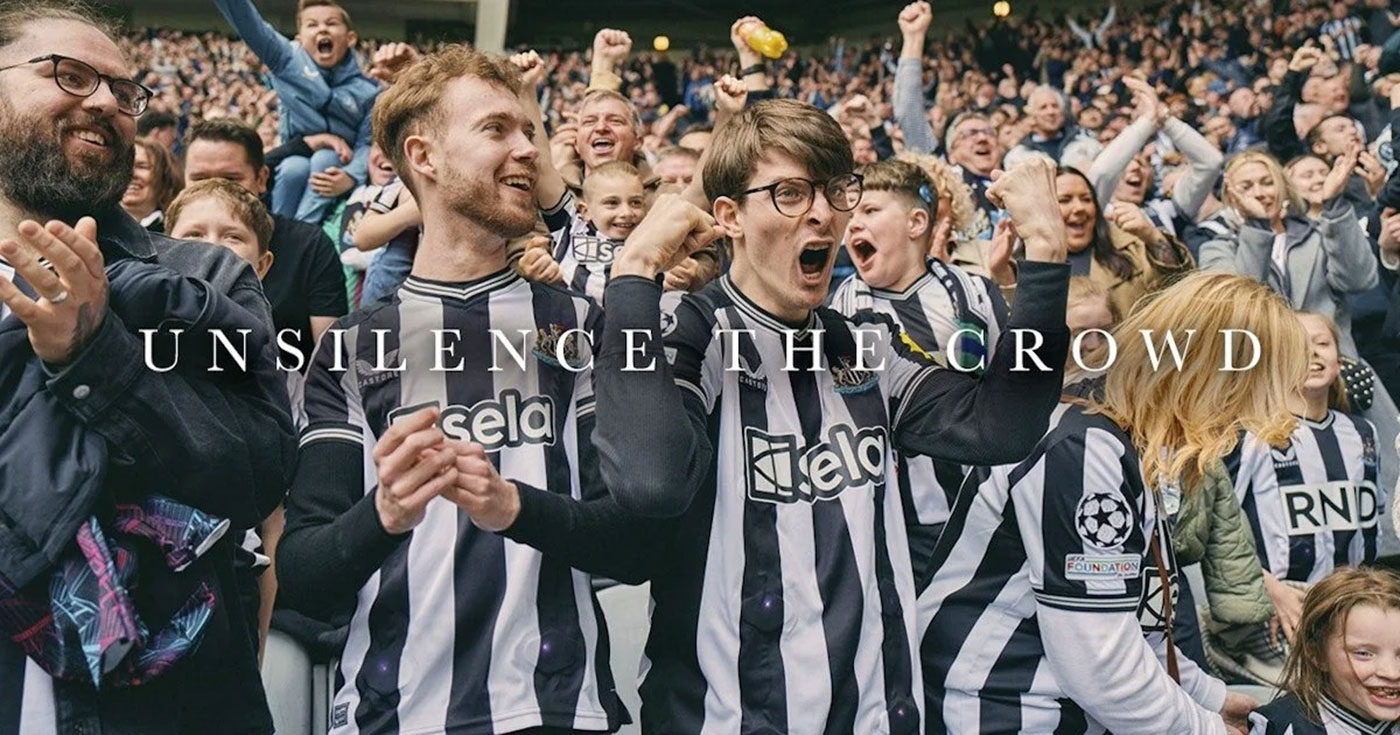
Fashion & Design Award
CuteCircuit, UK, The SoundShirt
The London-based wearable-technology fashion brand CuteCircuit, co-founded in 2004 by Francesca Rosella and Ryan Genz, created The SoundShirt as a multisensory wearable artwork that transforms sound into touch. Designed for both deaf and hearing audiences, it allows users to experience music, speech, and ambient sound as real-time haptic sensations mapped across the torso and arms using 28 actuators fitted across the shirt. The technology has been integrated into Newcastle United’s Premier League football stadium and Installed at the Lyric Opera of Chicago among other institutions. “The roar of the crowd spreads across your torso,” CuteCircuit says on its website, “when your team scores”. The company sees The SoundShirt as a “rethinking of design as an inclusive, empathetic practice”.
Rosella and Genz, who have won a number of awards for The SoundShirt, including a Webby 2025 Award for Best Wearable & Connected Device, said at the Lumen ceremony that it is sometimes not clear to artists that their work is “really understood by the community that is welcoming you [...] Our work is all about connecting people, making sure people can share experiences together.”
They thanked the Newcastle United fans Ryan and David for working with them to design the experience for the Newcastle stadium: “we’re really really grateful that we were able to build this community with them and really get their input to make this experience feel as good as they wanted it to feel.”

Hybrid Award
Carlo Van de Roer and Taika Waititi, US, Toru
The New Zealand artists Carlo Van de Roer, a film director and inventor, and Taika Waititi, the Academy Award-winning writer, actor, and film-maker, created Toru, a three-channel video installation and interactive digital work, to explore both mythology and new filmmaking technology. Toru, which was shown at the V&A in London in September 2025 as part of its Digital Design Weekend, uses film-making technology developed by Satellite-Lab, the R&D studio co-founded by Van de Roer and Stuart Rutherford, that allowed the artists to create multiple films of the same performance
Van de Roer, speaking at the awards in the absence of Waititi, stressed that Toru is a collaborative project and that the prize was also for Waititi and the singer-songwriter and actress Rita Ora, both of whom perform in the film, and who are married. The prize, he said, was for “everybody behind and in front of the camera in this project, which was about really using new technology to take a step forward, to also take a step backwards towards earlier forms of storytelling, pre-photographic work into myth and oral traditions.” He thanked Lumen “for embracing artists that are asking these questions and supporting us, thinking about how to reposition these technologies and culture.”

Nordic Award
Emil Dam Seidel & Dorotea Saykaly, Denmark, Telos I
TELOS I is a holographic, mixed reality, film and dance installation, choreographed and performed by the Canadian dancer Dorotea Saykaly and directed by her partner the Danish film-maker Emil Dam Seidel. In this fictional work, an AI created to assist humanity finds itself in an unknown void after the extinction of humankind and “creates itself a body in search of a new purpose”. Telos I premiered at the inaugural Compétition Immersive at the 2024 Festival de Cannes, becoming the first holographic film to be selected for competition at the festival.
The Nordic Award, given to the work by a finalist from a Nordic country with the highest jury score, is sponsored by Kunstsilo. Torill Haugen, Head of Innovation and Digital Development at the museum, explained at a discussion panel that she and the team at Kunstsilo had discovered Lumen in 2019 when they first looked to grow their interest in art and technology.
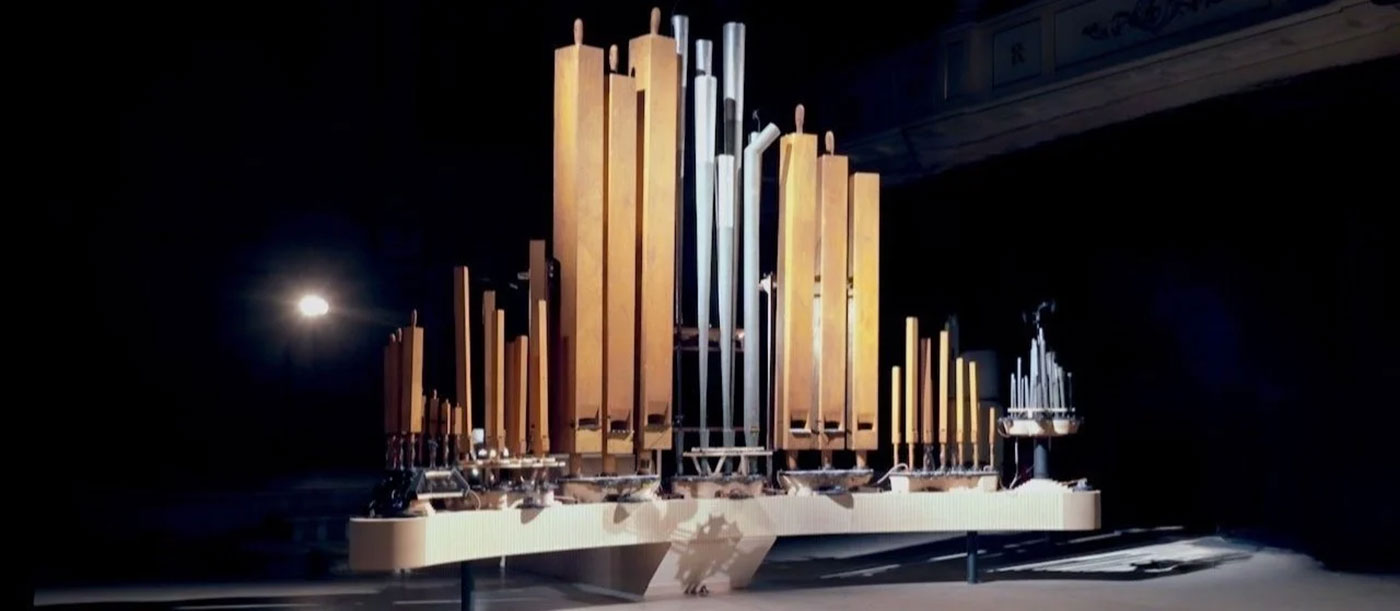
Identity & Culture Award
Navid Navab, Canada, Organism: In Turbulence
The Iranian-Canadian artist Navid Navab created Organism: In Turbulence as an investigative platform, revolving around a “robotically-prepared” 1910 Casavant pipe organ which Navab “rescued from the impending gentrification at a heritage site in Montreal, to liberate and sound its turbulent materiality, robotically unleashing long-silenced timbres after centuries of sonic repression.”
Speaking at the awards ceremony, Navab said: “From our eco-cidal data farms, feeding our isolation within echo chambers, to AI-assisted genocidal war machines in Palestine, Ukraine, Sudan, to patriarchal algorithms of control over women, life, and freedom, our technologies implicate us in relations of agential slavery and colonial violence. As artists, when we try to engage these issues via metaphors and mediations, the underlying technological networks of relation remain unchanged. Organism, from its conception to design and performances, enacts politics at the level of exchange, negotiating and orchestrating how things come to matter at every instance.”

Carla Rapoport Award
Andrey Chugunov, UK, a space for encapsulation
In a space for encapsulation, Andrey Chugunov, a Russian national living in Scotland and applying for UK citizenship, explores Scotland’s coastlines impacted by rising sea levels through photogrammetry, generative sound, and poetic narrative.
Introducing the prize in her name, Carla Rapoport, founder of The Lumen Prize, said that it was set up to “give a stipend and to allow an artist to use the money to further what they were doing.” The Lumen Prize finalists (from over 2,200 entries in total) were asked to apply for the prize, she said, so long as their project had an untold or forgotten story, and they could both describe what they would use the money for and indicate whether or not their project is tied to an institution. (The last category, Rapoport said, was not a deal breaker.)
Chugunov’s Russian citizenship meant he was unable to receive a visa to visit Norway, Rapoport said, and she read out a statement on his behalf in which he thanked Mark Daniels and New Media Scotland, Aberdeen Performing Arts, and Creative Scotland for supporting the development of a space for encapsulation and said he would use the stipend to complete the project “across the remaining regions of Scotland and to prepare a touring exhibition across the coastal towns I have visited and those still ahead.”
The project, Chugunov said in his statement, “traces the afterlives of industrialization along the Scottish coast. What moved me was not decay, but adaptation. Industrial structures and fabricated artifacts are now dissolving into sand and salt, forming hybrid assemblages — post-industrial, post-organic. I work with these places through photogrammetry and field recording. They do not operate as a traditional archive. They reveal fractures, gaps, distortions, and a dynamic, ever-eroding memory.”
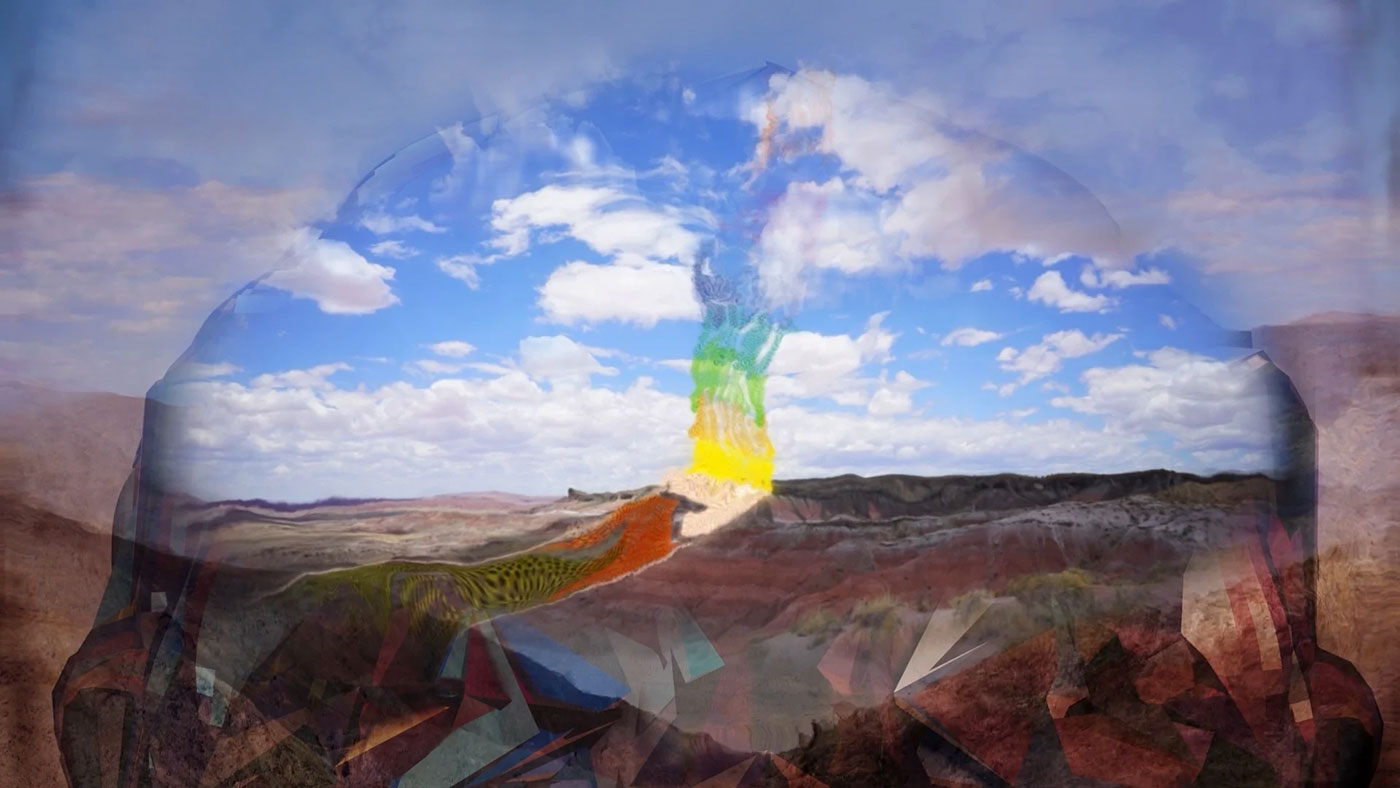
Special Commendation Award
Amelia Winger-Bearskin, US, I WOULD LIKE TO BE MIDNIGHT / I WOULD LIKE TO BE SKY
Amelia Winger-Bearskin (Seneca-Cayuga Nation of Oklahoma) is an artist who uses AI as a creative medium and conceptual framework. The award recognized Winger-Bearskin, who is Banks Family Chair of Artificial Intelligence and the Arts at the Digital Worlds Institute at the University of Florida, for her exploration of Indigenous futurism and computational storytelling. She foregrounds cultural memory and speculative worldbuilding in her work as forms of resistance and renewal.
Speaking at the awards ceremony, Winger-Bearskin addressed her work with the homeless. “Although sometimes we may remain unsheltered, we never are without a home because this planet will always and forever be our home,” she said. “I truly believe in the next few years we will end homelessness and I hope that you can put that dream within your heart as well because ending homelessness is possible and it has been done in many locations on this planet and it continues to finally find an end so that no one in our community will ever have to sleep on the street or have to die because of sleeping outdoors. So I hope that you can hold that in your heart, that space that knows we know how to end homelessness and we will be able to do so.”
Louis Jebb is Managing Editor of Right Click Save

